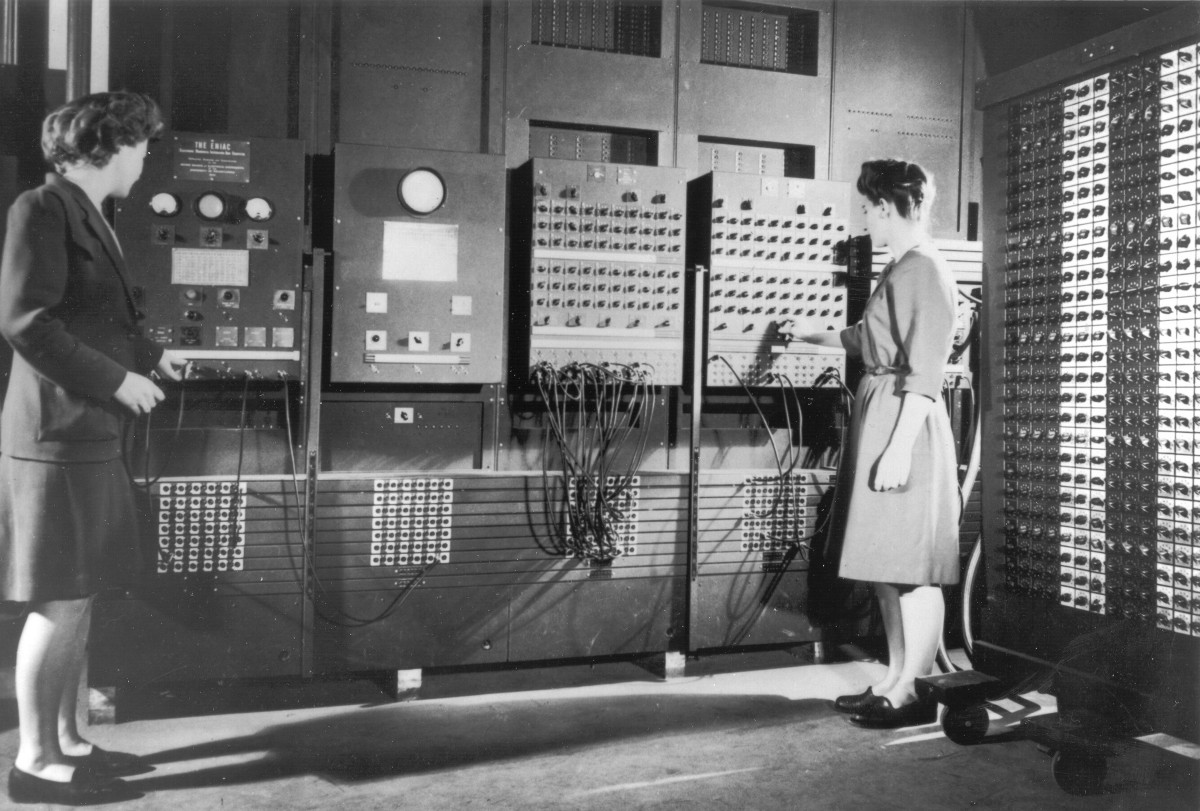On ENIAC’s Anniversary, a Nod to Its Female ‘Computers’
In 1946, when the first general-purpose electronic computer was made here at the University of Pennsylvania, women pioneers played key roles.

By Gwyneth Shaw
When the revolutionary Electronic Numerical Integrator and Computer (ENIAC) was unveiled at Penn in February 1946, two women had created the test run that wowed the media. The development of the world’s first computer led to the digital age of smartphones, touch screens, mobile devices, and electronics today.
But their work, and that of four other women who helped get ENIAC off the ground, was literally erased. Archival photos show women and men working on the massive machine, but the articles and pictures published feature only men. After a successful demonstration at what was then Penn’s Moore School of Electrical Engineering, the women weren’t invited to a celebratory dinner at Houston Hall.
Thanks to historians, filmmakers, and women in computer science who looked to them as role models, the “ENIAC Six” gained recognition decades later. Kathleen McNulty Mauchly Antonelli, Jean Jennings Bartik, Frances (Betty) Snyder Holberton, Marlyn Wescoff Meltzer, Frances Bilas Spence, and Ruth Lichterman Teitelbaum were inducted into the Women in Technology International Hall of Fame in 1997.
LeAnn Erickson, a Temple University professor and documentary filmmaker, featured the ENIAC programmers in her 2010 film, “Top Secret Rosies: The Female Computers of World War II.”
The movie traces the history of the female “computers” — the term was then a title for people who did calculations, not the machines that would replace them — who worked on classified U.S. Army ballistics calculations at Penn during World War II. (The title is a play on the classic “Rosie the Riveter” term for women who joined the workforce during the war, often taking on men’s jobs.)
Some of them moved from that program to the development of ENIAC. It was a missile-trajectory calculation, devised by Bartik and Holberton, that was the basis for the 1946 demonstration for the press.
The Philadelphia City Council designated Feb. 15 as ENIAC Day in 2011, as part of the celebration around the machine’s 65th anniversary.
Another documentary that’s specifically about the ENIAC programmers, “The Computers,” was released in 2015.
Erickson, a professor of film and video production, stumbled into the story while working on another documentary, about Philadelphia’s Mount Airy neighborhood. Twin sisters who were part of that documentary, Doris Polsky and Shirley Melvin, were leafing through old photos when they started talking about how they’d been recruited straight out of the Philadelphia High School for Girls to make calculations for the Army.
With men in demand for military service, women with an aptitude for math were brought in to calculate the trajectories for bullets and bombs, critical information that was then compiled into tables and distributed to the battlefields.
“They were the ones who got me started. They led me to Marlyn Mescoff, and she led me to Jean Bartik, and Jean led me to Kay McNulty Mauchly Antonelli, but Kay died before I could do that interview,” Erickson says. “It was very difficult to find subjects who felt like they had a good enough memory to talk about it.”
To mark ENIAC Day at Penn, “Top Secret Rosies” will be shown at the Penn Libraries’ Education Commons. The free event, which runs from 3 to 5 p.m, will also feature other activities, including on-demand sticker printing.
In the hour-long film, Bartik describes longing to leave her tiny Missouri town and spurning job offers to become a math teacher as she waited for the chance to come to Philadelphia.
“When they hired me, they sent a telegram and it said ‘report immediately,’ so I was on the Wabash the next midnight out of town,” says Bartik, who died in 2011.
The initial group did hand calculations and also used calculating machines, such as a differential analyzer, that produced an answer in 15 minutes that would take a person 40 hours to compute by hand. ENIAC, invented by John Mauchly and J. Presper Eckert of the Moore School (now the School of Engineering and Applied Science), was proposed to further speed the process.
The war ended before ENIAC was completed, although “Top Secret Rosies” details how the machine’s first successful problem, a calculation critical to the development of the hydrogen bomb, was executed by the female programmers.
The modular computer, which weighed 30 tons, contained 18,000 vacuum tubes and had 5 million hand-soldered joints, paved the way for the computer age. ENIAC was moved to the Aberdeen Proving Ground in 1947, but four of the original 40 panels are on display at Penn.
Erickson ended up creating an e-book, “The Computer Wore Heels,” and other educational materials as part of her effort to write the women back into the history of early computers. (The movie is available for streaming anytime.)
“It brings history alive when you can experience it that way,” she says. “All of my subjects have now passed away. It’d sad to think on the one hand that you’re losing this really amazing generation of people, but on the other hand I feel really grateful that I was able to record these stories.”
